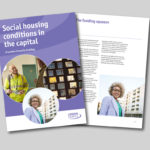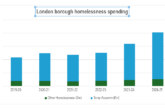New analysis suggests social rent levels set by the Government will leave London boroughs with a “black hole” in their social housing finances of up to £700m over the next four years, despite the “desperate” need to improve housing conditions and build new homes in the capital.
The cross-party London Councils group has assessed the impact of social rent policy on boroughs’ housing revenue accounts (HRAs) — effectively the budgets for managing their social housing stock, which includes paying for repairs and maintenance [1].
The analysis incorporates longer-term research commissioned by the London Housing Directors’ Group [2] from Savills, which forecasts that London boroughs will have to make savings to their HRA budgets for the next 20 years due to social rent constraints and the current impact of inflation.
Social housing finance pressures are a particular concern in the capital. London boroughs let around 390,000 social homes [3] and are making the case for more flexibilities and sustainable funding arrangements from central government. The Government confirmed in January a maximum permitted increase to social rents of 7.7% in 2024-25 [4].
Although official government policy is to let social rents rise by a maximum of inflation (measured by the Consumer Price Index, CPI) plus an additional 1% (referred to as ‘CPI+1%’), in five of the past seven years the government has intervened to set rent levels well below inflation — leading to significant deficits in HRAs.
With inflation on core expenditure such as building materials and repairs contractors expected to continue outpacing CPI in the coming years, boroughs warn that increases in their social housing costs will remain significantly above increases in their income despite a return to the CPI+1% rent policy. The cumulative impact of costs continuing to run higher than rental income will equate to nearly £900m over 20 years, according to Savills.
London Councils warns that this squeeze on social housing resources represents a substantial real-terms reduction in funding available for improving housing conditions and building new homes. Boroughs anticipate the majority of the savings they are required to make will come out of their budgets for social housing development and for undertaking repairs.
Key priorities for boroughs include:
- Raising standards: Boroughs acknowledge that London has the lowest social housing standards of any region in the country. A disproportionately high number of Housing Ombudsman maladministration cases for damp and mould relate to social housing in the capital. London’s stock faces particular challenges, as it is generally older and less insulated than in other parts of the country. There is also a higher proportion of tall buildings and flats, which complicates maintenance, plus higher rates of overcrowding.
- Building safety: Significant funding is needed to ensure social housing meets the highest building safety standards. The Local Government Association estimates £7.7bn is needed for councils across England in 2023-2030 to achieve this in their housing stock, including through installing sprinklers and improving compartmentation to reduce fire risk.
- Decarbonisation: Boroughs are working together to achieve substantial carbon reductions through retrofitting housing. However, London Councils estimates it will cost at least £49bn to boost all homes (not just social housing) in the capital to an average EPC rating of ‘B’ by 2030.
- Building new social homes: London faces the most severe homelessness crisis in the country and over 320,000 London households are on social housing waiting lists. London Councils estimates that one in 50 Londoners are homeless and living in temporary accommodation arranged by their local borough. Boroughs are determined to keep increasing delivery of new affordable homes, including social housing, but high construction costs have led to many projects becoming unviable without additional funding.
With the Government expected to launch a consultation on future rent policy in the coming months, London Councils is seeking more funding support for social housing providers and investment in the sector. This includes more flexibility for local authorities over setting rent levels and the use of money raised through Right to Buy council house sales, new borrowing powers, and additional government grant funding for building social homes.
Cllr Darren Rodwell, London Councils’ Executive Member for Regeneration, Housing & Planning, said: “At a time when we desperately need more investment in social housing, boroughs are facing year after year of budget squeezes.
“Social housing is vital to London’s social and economic success, and we want the sector to thrive. Boroughs are driving the improvements on standards, on safety, and on net zero that our tenants — but also the government — are so keen to see.
“We know cost-of-living pressures remain a major concern for many tenants and we support measures designed to help low-income households struggling with their finances. However, the Government’s rent policy leaves us with a black hole of nearly £700m in our social housing finances over the next four years. Considering the massive pressures the sector faces, it feels like we’ve been left with mission impossible.
“Ministers must ensure boroughs get the resources we need to secure a better future for London’s social housing.”
Joanne Drew, Co-Chair of the London Housing Directors’ Group, commented: “This analysis paints a bleak picture for boroughs’ housing revenue accounts and our ability to invest in social housing.
“From damp and mould through to building safety and decarbonisation, there are enormous challenges in the capital. Boroughs have great ambitions as social housing providers, but with our income failing to meet our costs and spending cuts needed to balance the books it becomes extremely difficult to secure the progress we all want to see.”
[1] All local authorities that own social housing are required to record expenditure and income relating to this housing stock through ring-fenced housing revenue accounts (HRAs).
HRAs are held separately from the council’s general fund and are bound by legislation defining what can and cannot be charged to the HRA.
HRA self-financing was introduced by the government in 2012. Since then, local authorities have been expected to balance HRA budgets according to rules set out by central government. The most relevant of these rules is the government-defined policy on rent setting.
HRAs are not allowed to budget for a deficit. Any projected deficit must be addressed through spending cuts or use of HRA reserves.
London Councils’ new analysis includes the financial impact on HRAs of the 2023-24 cap of 7% on social rent increases, as well as the 7.7% permitted increase for 2024-25.
[2] The London Housing Directors’ Group is a professional network of senior housing officers from across London’s 33 local authorities.
[3] There are over 800,000 social rented homes in London — accounting for 20% of the capital’s 3,671,000 homes. London boroughs let around 390,000 of those social homes, with the rest owned by housing associations.
[4] Source: Limit on annual rent increases 2024-25: https://www.gov.uk/government/publications/rent-standard/limit-on-annual-rent-increases-2024-25-from-april-2024-accessible-version (updated on 4th January 2024)
Earlier this month, London Councils expressed “extreme concern” at the Government’s decision to stop letting local authorities keep all money raised from council house sales. More on that story here.










